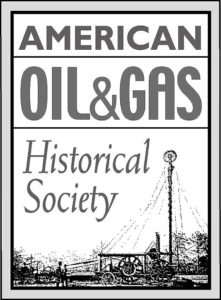by Bruce Wells | Oct 6, 2025 | This Week in Petroleum History
October 6, 1886 – Natural Gas fuels Glass Manufacturing –
A 900-foot-deep natural gas well in a cornfield near Kokomo, Indiana, led to the establishment of the Indiana Natural Gas Company, and in 1888, the Opalescent Glass Works, which has been in continuous operation since. The state’s first natural gas well was completed in 1867, seeking oil reserves (see Indiana Natural Gas Boom).
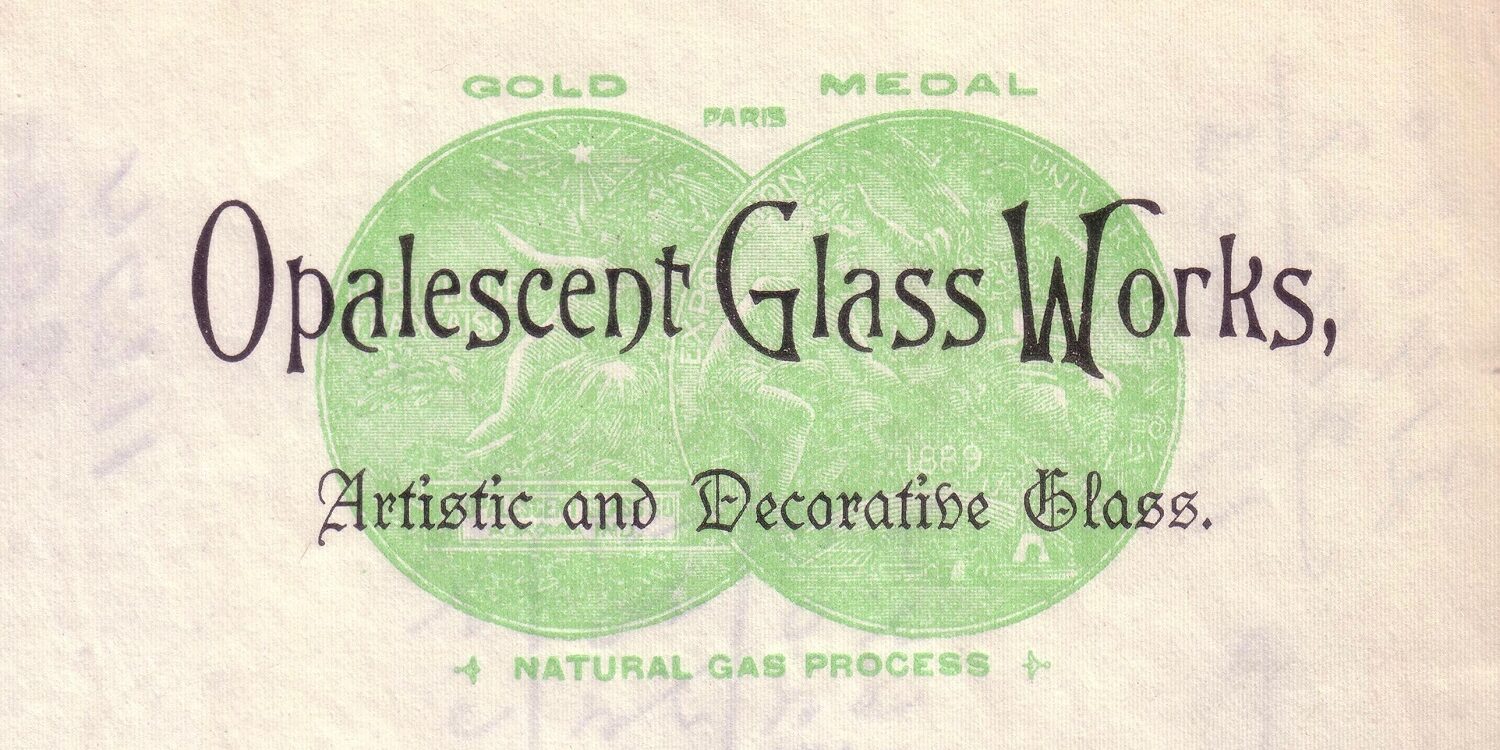
Opalescent Glass Works won a gold medal at the 1889 Exposition Universelle in Paris for its “natural gas process” glass. Photo courtesy Kokomo Opalescent Glass.
Opalescent Glass Works, today Kokomo Opalescent Glass, almost went bankrupt when natural gas supplies dwindled, but in 1893 it recovered by selling electric insulators to Edison General Electric Company — and thousands of pounds of stained glass to Tiffany studios in New York City.
October 6, 1957 – Society of Petroleum Engineers established
The first board of directors meeting of the Society of Petroleum Engineers (SPE) established the professional society in an expansion of the American Institute of Mining, Metallurgical and Petroleum Engineers (AIME), which had created a Petroleum Division in 1922.

An American Institute of Mining Engineers program led to the Society of Petroleum Engineers.
AIME began in 1871, when a small group of Pennsylvania mining engineers sought to “preserve their collective knowledge and experiences for the benefit of future engineers.” SPE has grown into an independent, nonprofit global society with 132,000 members in 146 countries.
October 7, 1859 – First U.S. Oil Well catches Fire
The wooden derrick and engine house of America’s first oil well erupted in flames along Oil Creek at Titusville, Pennsylvania. The well had been completed the previous August by Edwin L. Drake for George Bissell and the Seneca Oil Company of New Haven, Connecticut. Working with driller William “Uncle Billy” Smith, Drake used steam-powered cable-tool technology.
The first U.S. oil well fire began when Uncle Billy inspected a vat of oil with an open lamp. When the lamp’s flame set gases alight, the conflagration consumed the derrick, the stored oil, and the driller’s home. Drake and Seneca Oil Company would quickly rebuild at the already famous well site.
Learn more in First Oil Well Fire.

October 7, 2014 – 200th Anniversary of Ohio Oil Discovery
The Noble County Historical Society of Caldwell, Ohio, hosted a 200th anniversary festival and park dedication celebrating a brine well drilled with a spring pole that produced oil. The 1814 well can be found at Thorla McKee Park, named for Silas Thorla and Robert McKee, the entrepreneurs who established the local salt works, according to researcher Dave Baker in “Early Marietta.”
In 2015, Baker reported the historic well site included the remains of its original sycamore log casing beneath a replica springpole. Thoria and McKee separated the oil from the salt water by soaking it up with blankets before bottling it to sell as a medicinal potion. The remaining brine was boiled to extract the salt. In 1992, the Noble County Department of Tourism and the Ohio Historical Society dedicated a historic marker near the Caldwell site. Ohio’s first well drilled exclusively for oil was completed near Macksburg in the autumn of 1860.
October 8, 1915 – Elk Basin oilfield discovered in Wyoming
An exploratory well drilled in a remote Wyoming valley opened the giant Elk Basin oilfield. Completed by the Midwest Refining Company near the Montana border, the wildcat well produced 150 barrels of high-grade “light oil” a day. The oil needed little refining to provide quality lubricants.

“Gusher coming in, south rim of the Elk Basin field, 1917.” Photo courtesy American Heritage Center, University of Wyoming.
Geologist George Ketchum first recognized the potential of the basin as a source of oil deposits. Ketchum had explored the remote area in 1906 with C.A. Fisher while farming near Cowley, Wyoming. The Elk Basin extended from Carbon County, Montana, into northeastern Park County, Wyoming.
Fisher was the first geologist to map sections of the Bighorn Basin southeast of Cody, Wyoming, where oil seeps had been found as early as 1883. The Wyoming oilfield discovery in unproven territory attracted new ventures like Elk Basin United Oil Company, investors, and oilfield service companies.
Learn more in First Wyoming Oil Wells.

October 8, 1923 – First International Petroleum Exposition and Congress
Five thousand visitors attended the rainy opening day of the first International Petroleum Exposition and Congress in downtown Tulsa, an event that would return for almost six decades.
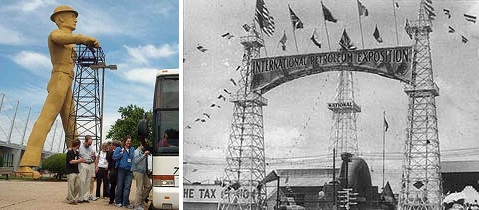
Although still a tourist attraction, the 76-foot-tall Golden Driller arrived decades after Tulsa’s first International Petroleum Exposition in 1923.
With annual attendance growing to more than 120,000, Mid-Continent Supply Company of Fort Worth introduced the original Golden Driller of Tulsa at the expo in 1953. Economic shocks beginning with the 1973 OPEC oil embargo depressed the industry, and after 57 years, the International Petroleum Exposition ended in 1979.
October 9, 1999 – Converted Offshore Platform launches Rocket
Sea Launch, a Boeing-led consortium of companies from the United States, Russia, Ukraine, and Norway, launched its first commercial rocket using the Ocean Odyssey, a modified semi-submersible drilling platform. After a demonstration flight in March, a Russian Zenit-3SL rocket carried a DirecTV satellite to geostationary orbit.
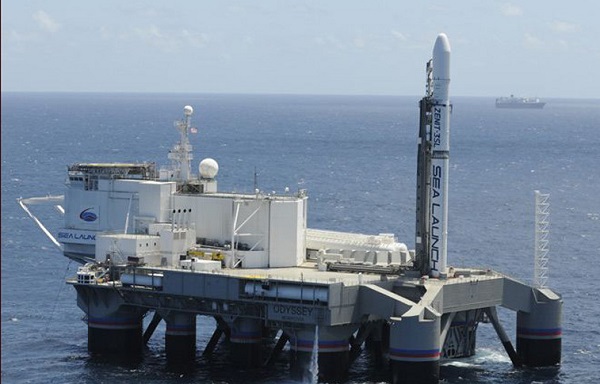
Ocean Odyssey, a modified semi-submersible drilling platform, became the world’s first floating equatorial launch pad in 1999. Photo courtesy Sea Launch.
In 1988, the former drilling platform had been used by Atlantic Richfield Company (ARCO) for North Sea explorations. The Ocean Odyssey made 36 more rocket launches until 2014, when the consortium ended after Russia illegally annexed Ukraine’s Crimean peninsula.
Learn more in Offshore Rocket Launcher.

October 10, 1865 – Oil Pipeline constructed in Pennsylvania
A two-inch iron pipeline began transporting oil five miles through hilly terrain from a well at booming Pithole, Pennsylvania, to the Miller Farm Railroad Station at Oil Creek. With their livelihoods threatened, teamsters attempted to sabotage the pipeline until armed guards intervened. A second oil pipeline would begin operating in December.
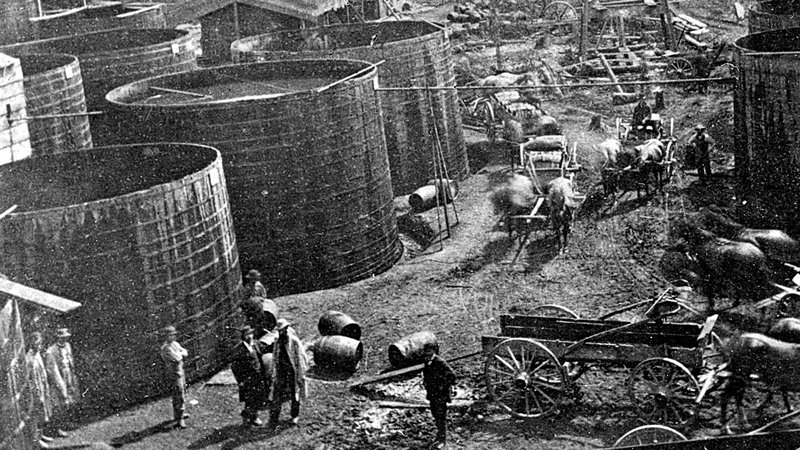
Oil tanks at the boom town of Pithole, Pennsylvania, where Samuel Van Syckel built a five-mile pipeline in 1865. Photo courtesy Drake Well Museum.
Built by Samuel Van Syckel, who had formed the Oil Transportation Association, the pipeline used 15-foot welded joints. Three 10-horsepower Reed and Cogswell steam pumps pushed the oil at a rate of 81 barrels per hour. With up to 2,000 barrels of oil arriving daily at the terminal, more storage tanks were soon added. The pipeline transported the equivalent of 300 teamster wagons working for 10 hours.
“The day that the Van Syckel pipeline began to run oil a revolution began in the business,” proclaimed Ida Tarbell in her 1904 History of the Standard Oil Company. “After the Drake well, it is the most important event in the history of the Oil Regions.”
_______________________
Recommended Reading: The Extraction State, A History of Natural Gas in America (2021); Myth, Legend, Reality: Edwin Laurentine Drake and the Early Oil Industry (2009); Where it All Began: The story of the people and places where the oil & gas industry began: West Virginia and southeastern Ohio
(2009); Where it All Began: The story of the people and places where the oil & gas industry began: West Virginia and southeastern Ohio (1994); Black Gold, Patterns in the Development of Wyoming’s Oil Industry (1997); Tulsa Where the Streets Were Paved With Gold – Images of America
(1994); Black Gold, Patterns in the Development of Wyoming’s Oil Industry (1997); Tulsa Where the Streets Were Paved With Gold – Images of America (2000); Offshore Pioneers: Brown & Root and the History of Offshore Oil and Gas
(2000); Offshore Pioneers: Brown & Root and the History of Offshore Oil and Gas (1997); Western Pennsylvania’s Oil Heritage
(1997); Western Pennsylvania’s Oil Heritage (2008); Oil and Gas Pipeline Fundamentals
(2008); Oil and Gas Pipeline Fundamentals (1993); Arizona Rocks & Minerals: A Field Guide to the Grand Canyon State
(1993); Arizona Rocks & Minerals: A Field Guide to the Grand Canyon State (2010). Your Amazon purchase benefits the American Oil & Gas Historical Society. As an Amazon Associate, AOGHS earns a commission from qualifying purchases.
(2010). Your Amazon purchase benefits the American Oil & Gas Historical Society. As an Amazon Associate, AOGHS earns a commission from qualifying purchases.
_______________________
The American Oil & Gas Historical Society (AOGHS) preserves U.S. petroleum history. Please become an AOGHS annual supporter and help maintain this energy education website and expand historical research. For more information, contact bawells@aoghs.org. Copyright © 2025 Bruce A. Wells. All rights reserved.
by Bruce Wells | Sep 29, 2025 | This Week in Petroleum History
September 30, 2006 – Roughnecks Statue dedicated at Signal Hill –
A bronze “Tribute to the Roughnecks” statue was dedicated near the Alamitos No. 1 well, which in 1921 revealed California’s prolific Long Beach oilfield 20 miles south of Los Angeles.
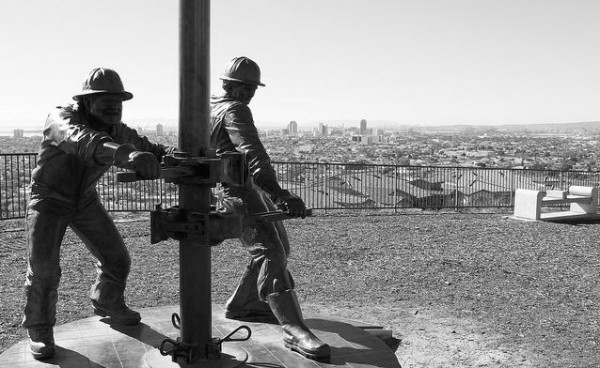
Signal Hill once had so many derricks people called it Porcupine Hill. The city of Long Beach is visible in the distance from the “Tribute to the Roughnecks” statue by Cindy Jackson.
The statue by Cindy Jackson has since commemorated the Signal Hill Oil Boom, serving as “a tribute to the petroleum pioneers for their success here, a success which has, by aiding in the growth and expansion of the petroleum industry, contributed so much to the welfare of mankind.”
October 1, 1908 – Ford Motor Company produces First Model T
The first production Ford Model T rolled off the assembly line in Detroit. Between 1908 and 1927, Ford built about 15 million more, each fueled by inexpensive gasoline. The popularity of the Model T was timely for the U.S. petroleum industry, which faced falling demand for kerosene as consumers switched to electric lighting.
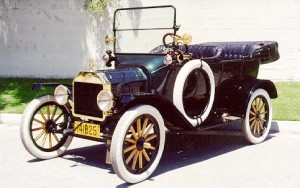
Ford Model T tires were white until 1910, when the petroleum product carbon black was added to improve durability.
New major oilfield discoveries, especially the 1901 “Lucas Gusher” at Spindletop Hill near Beaumont, Texas, helped meet growing demand for what had been a refining byproduct, gasoline.
October 1, 1920 – Gonzaullas becomes a Texas Ranger
Manuel T. Gonzaullas joined the Texas Rangers — and rowdy Texas boom towns would never be the same. He soon became known as “Lone Wolf” Gonzaullas.

“World’s Richest Acre Park, where once stood the world’s greatest concentration of oil wells.” A street scene in Kilgore, Texas, depicting steel derricks behind stores, is one of many by Russell Lee (1903-1986) preserved by the Library of Congress.
In East Texas, when the streets of downtown Kilgore sprouted oil derricks, the population grew from 700 to 10,000 in two weeks. With Depression-era petroleum discoveries multiplying, oil boom towns often attracted criminals. Riding a black stallion named Tony and sporting two pearl-handled .45 pistols, Gonzaullas soon earned a reputation for strictly enforcing the law.
October 1, 1942 – Water Injection begins in East Texas
The East Texas Salt Water Disposal Company drilled the first saltwater injection well in the 12-year-old East Texas oilfield near the towns of Tyler, Longview, and Kilgore. As early as 1929, the Federal Bureau of Mines had determined injecting recovered saltwater into formations could increase reservoir pressures and oil production.
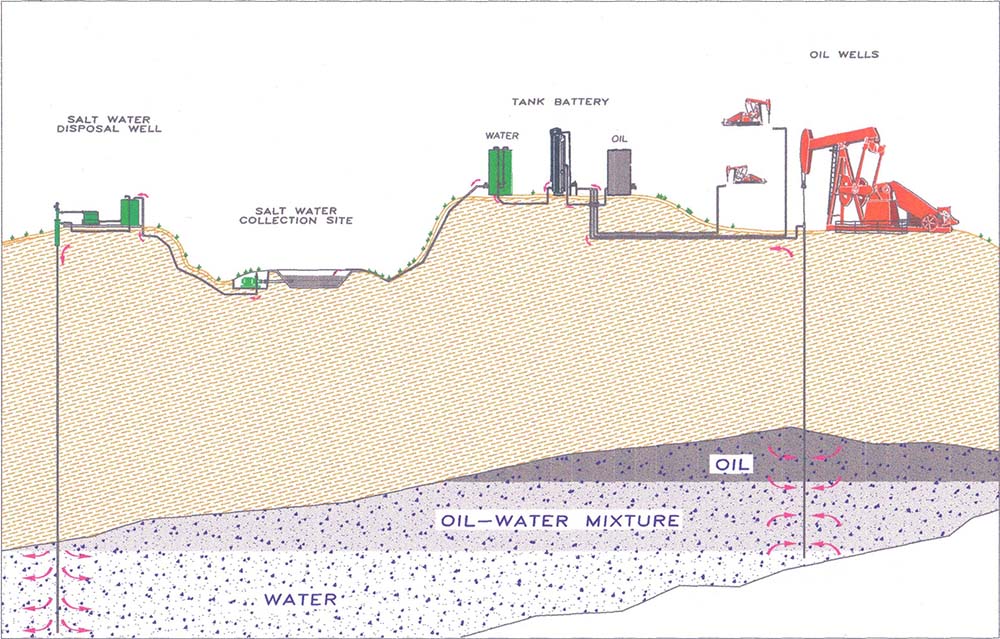
Saltwater injection wells improve oil production and keep marginal East Texas wells viable. Illustration courtesy East Texas Salt Water Disposal Company.
The Texas Railroad Commission established the saltwater disposal company as a public utility to operate in the oilfield. The company treated and reinjected about 1.5 billion barrels of saltwater in its first 13 years, prompting the commission to proclaim saltwater injection as the “greatest oil conservation project in history.”
October 2, 1919 – Future “Mr. Tulsa” incorporates Skelly Oil
Skelly Oil Company incorporated in Tulsa, Oklahoma, with founder William Grove Skelly as president. He had been born in 1878 in Erie, Pennsylvania, where his father hauled oilfield equipment in a horse-drawn wagon.

Born near Pennsylvania oilfields, William Skelly founded Skelly Oil Company in 1919 — and led an international petroleum exposition for 32 years, helping to make Tulsa the “Oil Capital of the World.”
Skelly’s success in the El Dorado oilfield east of Wichita, Kansas, helped him launch Skelly Oil and other ventures, including Midland Refining Company, which he founded in 1917. As Tulsa promoted itself as “Oil Capital of the World,” Skelly became known as “Mr. Tulsa.”
Skelly served as president of Tulsa’s famous International Petroleum Exposition for 32 years until his death in 1957.

October 3, 1930 – East Texas Oilfield discovered on Widow’s Farm
Ninety-five years ago, with a crowd of more than 4,000 expectant landowners, leaseholders, creditors, and others watching, the Daisy Bradford No. 3 wildcat well was successfully shot with nitroglycerin near Kilgore, Texas.
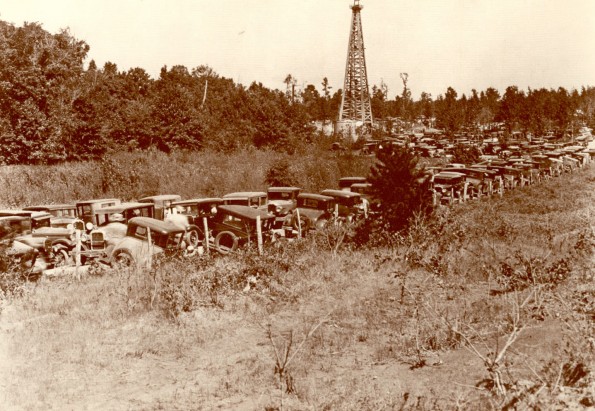
Spectators gathered on the widow Daisy Bradford’s farm near Kilgore, Texas, to watch the October 3, 1930, “shooting” of the discovery well of what proved to be the largest oilfield in the lower 48 states. Photo courtesy Jack Elder, The Glory Days.
“All of East Texas waited expectantly while Columbus ‘Dad’ Joiner inched his way toward oil,” explained historian Jack Elder in 1986. “Thousands crowded their way to the site of Daisy Bradford No. 3, hoping to be there when and if oil gushed from the well to wash away the misery of the Great Depression.”
Geologists were stunned when it became apparent the remote wildcat well on the widow Daisy Bradford’s farm — along with two other wells far to the north — were part of the same oil-producing formation (the Woodbine) that encompassed more than 140,000 acres. The “Black Giant” would produce billions of barrels of oil in coming decades.
Learn more in East Texas Oilfield Discovery.
October 3, 1980 – Museum opens in East Texas Oilfield
Fifty years after the discovery of the East Texas oilfield, the East Texas Oil Museum at Kilgore College opened as “a tribute to the independent oil producers and wildcatters, the men and women who dared to dream as they pursued the fruits of free enterprise.”

The East Texas Oil Museum since 1980 has hosted events and maintained exhibits preserving the “Black Giant” oilfield discovered during the Great Depression. Photos by Bruce Wells.
Established with funding from the Hunt Oil Company, the museum at Kilgore College recreated a 1930s boom town atmosphere. The museum, which is hosting special events on its 45th birthday, maintains a database that offers keyword search and advanced search options — along with a “random Images” button to browse photography from a wide assortment of online records.
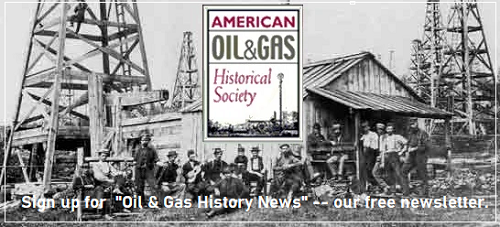
October 4, 1866 – Oil Fever spreads to Allegheny River Valley
Just 15 miles east of Titusville, Pennsylvania, site of the first U.S. oil well, an oilfield discovery at Triumph Hill sparked another wild rush of speculators and new drilling. America’s petroleum industry was barely seven years old when wooden cable-tool derricks and engine houses replaced hemlock trees along the Allegheny River.
October 4, 1901 – Drake Memorial dedicated in Pennsylvania
More than 2,500 people, including his widow, Laura Dowd Drake, attended the unveiling of a monument to the “father of the petroleum industry,” Edwin L. Drake, who had died in relative obscurity in 1880. Standard Oil Company executive Henry Rogers commissioned the marble, semi-circle memorial in Titusville, Pennsylvania.
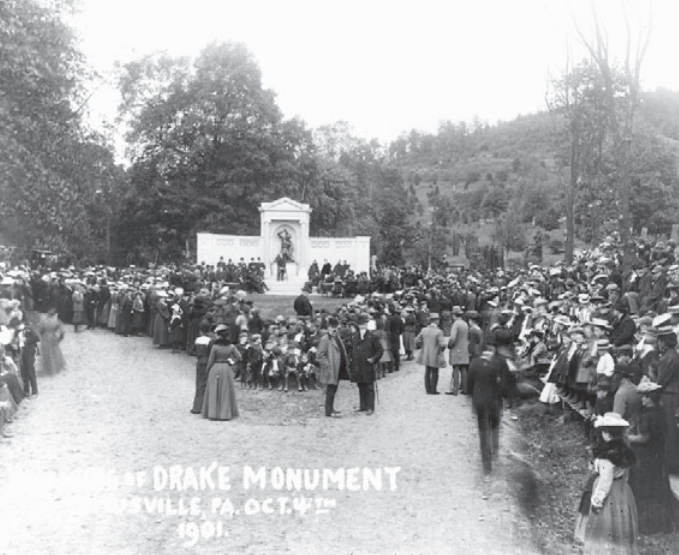
Unveiling of the Drake Monument in Titusville, Pennsylvania, on October 4,1901. Thousands attended the dedication in Woodlawn Cemetery. Photo by John Mather courtesy Drake Well Museum.
The monument, which includes a bronze statue by Charles Henry Niehaus, was dedicated in Woodlawn Cemetery. Learn more by visiting Titusville’s Drake Well Museum and Park.
October 5, 1915 – Science of Petroleum Geology reveals Oilfield
Using the new earth science of petroleum geology for finding oil led to the discovery of the giant Mid-Continent field in central Kansas. Drilled by Wichita Natural Gas Company, a subsidiary of Cities Service Company, the well revealed the 34-square-mile El Dorado oilfield.
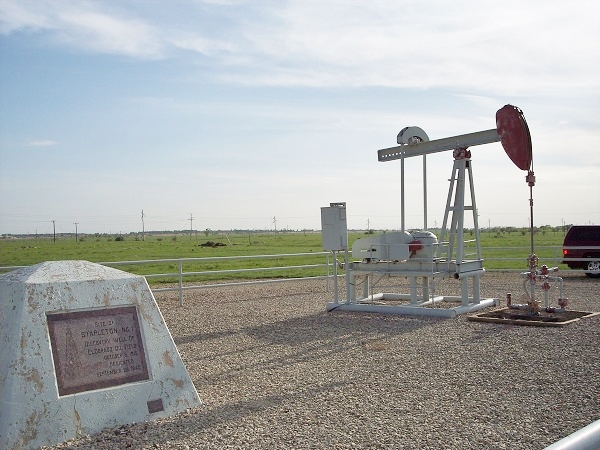
The Stapleton No. 1 well in 1915 revealed the El Dorado, Kansas, oilfield, among the largest in the world. By 1919, Butler County had more than 1,800 producing oil wells. Photo by Bruce Wells.
“Pioneers named El Dorado, Kansas, in 1857 for the beauty of the site and the promise of future riches, but not until 58 years later was black rather than mythical yellow gold discovered when the Stapleton No. 1 oil well came in on October 5, 1915,” explained geologist Lawrence Skelton in 1997.
The Stapleton No. 1 well east of Wichita initially found oil at a depth of 600 feet before being deepened to 2,500 feet to produce 110 barrels of oil a day from the Wilcox sands. Natural gas discoveries one year earlier at nearby Augusta had prompted El Dorado civic leaders to seek their own geological study of Mid-Continent fields.
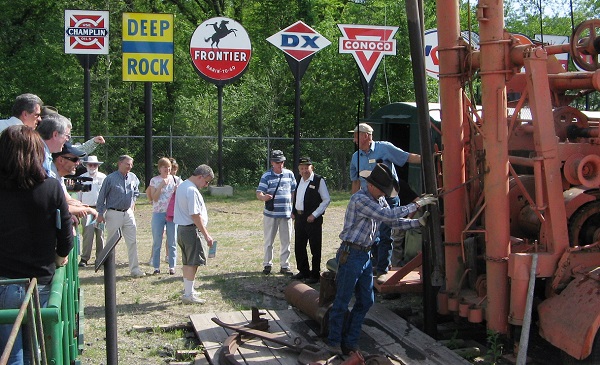
The Stapleton No. 1 well and the Kansas Oil Museum preserve a 1915 oil discovery. Photo by Bruce Wells.
The Kansas Oil Museum preserves the state’s petroleum heritage with historic oilfield equipment displayed on 10 acres east of the city. Museum exhibits describe how lessons from the El Dorado field helped launch petroleum geology as a profession while establishing El Dorado as a center for refining.
Learn more in the Kansas Oil Boom.

October 5, 1958 – Water Park opens in West Texas for One Day
A water park inside a Depression-era experimental concrete oil tank opened to the public in West Texas. The day’s festivities at Monahans attracted swimmers, boaters, anglers, and even water skiers to the massive, manmade lake — before leaks at the seams forced it to close the next day.
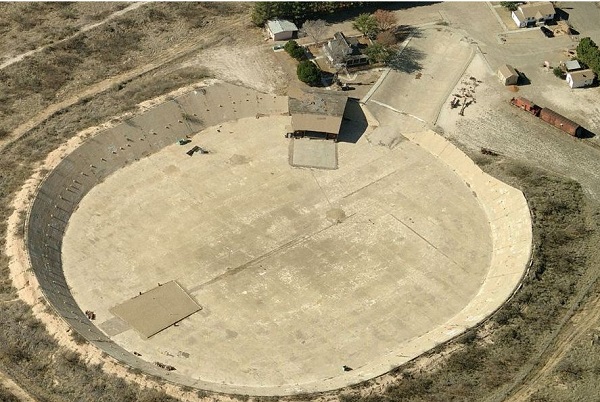
The Million Barrel Museum’s site was originally built to store Permian Basin oil. For scale, note the railroad car and caboose exhibit at upper right.
A local couple had attempted to find a good use for the 525-foot by 422-foot “million barrel reservoir” once covered by a redwood dome roof. The concrete tank had been completed in 1928 by Shell Oil due to a lack of pipelines for Permian Basin oil. Shell stopped using the tank because the company could not prevent oil from leaking at the seams.
Learn more in Million Barrel Museum.
_______________________
Recommended Reading: Signal Hill, California – Images of America (2006); From Here to Obscurity: An Illustrated History of the Model T Ford, 1909 – 1927
(2006); From Here to Obscurity: An Illustrated History of the Model T Ford, 1909 – 1927 (1971); Artificial Lift-down Hole Pumping Systems
(1971); Artificial Lift-down Hole Pumping Systems (1984); An adventure called Skelly: A history of Skelly Oil Company through fifty years, 1919-1969 (1970); The Black Giant: A History of the East Texas Oil Field and Oil Industry Skullduggery & Trivia
(1984); An adventure called Skelly: A history of Skelly Oil Company through fifty years, 1919-1969 (1970); The Black Giant: A History of the East Texas Oil Field and Oil Industry Skullduggery & Trivia (2003); Early Texas Oil: A Photographic History, 1866-1936
(2003); Early Texas Oil: A Photographic History, 1866-1936 (2000); Western Pennsylvania’s Oil Heritage
(2000); Western Pennsylvania’s Oil Heritage (2008); The fire in the rock: A history of the oil and gas industry in Kansas, 1855-1976
(2008); The fire in the rock: A history of the oil and gas industry in Kansas, 1855-1976 (1976); Chronicles of an Oil Boom: Unlocking the Permian Basin
(1976); Chronicles of an Oil Boom: Unlocking the Permian Basin (2014). Your Amazon purchase benefits the American Oil & Gas Historical Society. As an Amazon Associate, AOGHS earns a commission from qualifying purchases.
(2014). Your Amazon purchase benefits the American Oil & Gas Historical Society. As an Amazon Associate, AOGHS earns a commission from qualifying purchases.
_______________________

_______________________
The American Oil & Gas Historical Society (AOGHS) preserves U.S. petroleum history. Please become an AOGHS annual supporter and help maintain this energy education website and expand historical research. For more information, contact bawells@aoghs.org. Copyright © 2025 Bruce A. Wells. All rights reserved.
by Bruce Wells | Sep 22, 2025 | This Week in Petroleum History
September 22, 1955 – End of Signal Oil “The Whistler” Radio Show –
Sponsored since 1942 by the largest independent oil company on the West Coast, the last episode of the radio drama “The Whistler” aired on CBS Radio. Signal Oil Company was established in 1921 by Samuel Mosher as the Signal Gasoline Company during California’s Signal Hill oil boom.
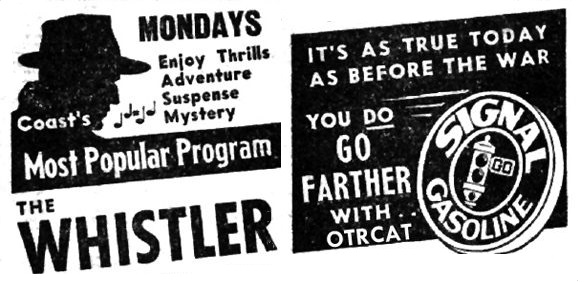
Signal Oil Company sponsored the West Coast CBS Radio mystery program “The Whistler” from 1942 to 1955.
The company’s 1931 partnership with Standard Oil of California (Socal) led to sponsorship of many radio programs, according to Media Heritage. All 692 weekly episodes of Signal Oil’s popular radio mystery began with echoing footsteps and an eerie whistle, followed by “That whistle is your signal for the Signal Oil program.”
September 23, 1918 – Wood River Refinery goes Online
The Roxana Petroleum Company Wood River (Illinois) facility began refining crude oil — processing more than two million barrels of oil from Oklahoma oilfields in its first year of operation. Roxana Petroleum was the 1912 creation of the Royal Dutch/Shell Group, which also founded the American Gasoline Company in Seattle to distribute the fuel on the West Coast.
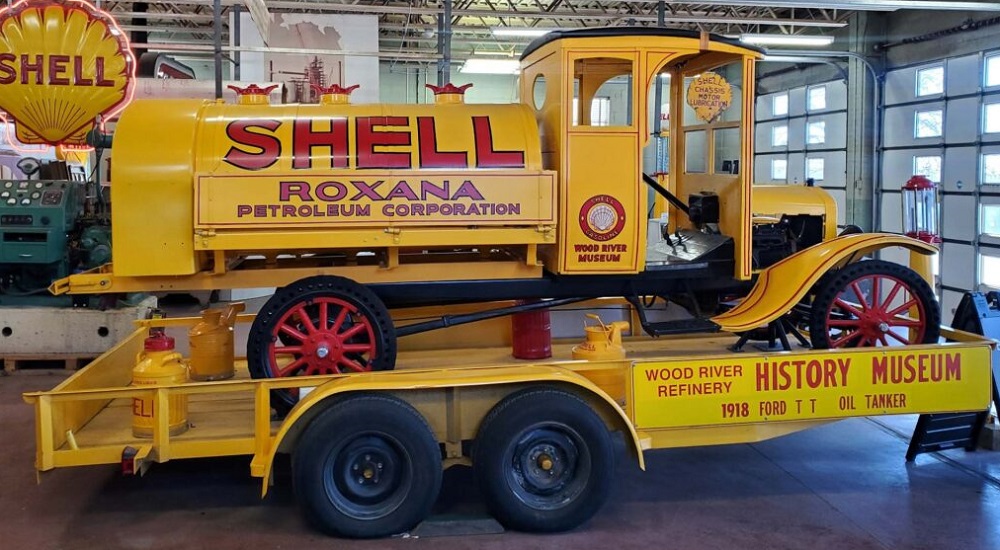
A small group of retirees in 1986 established the Wood River Refinery History Museum in three former Shell research laboratory buildings at Roxana, Illinois. Museum exhibits include a restored 1918 Shell tank truck and other large equipment in Building Two.
Roxana Petroleum produced high-quality oil from Oklahoma oilfields to be refined at the Wood River plant 15 miles northeast of St. Louis, today the largest refinery operated by Phillips 66. In 1928, Roxana Petroleum built an experimental oil storage reservoir in West Texas (see Million Barrel Museum).

September 23, 1933 – Standard Oil of California visits Saudi Arabia
Invited by Saudi Arabian King Abdel Aziz, geologists from Standard Oil Company of California arrived at the Port of Jubail in the Persian Gulf. Searching the desert for petroleum and “kindred bituminous matter,” they discovered a giant oilfield. The Saudi Arabia and Standard Oil partnership would become the Arabian American Oil Company (Aramco), later joined by other major U.S. companies.
September 23, 1947 – New Patent for “Hortonspheres”
Horace E. Horton’s Chicago Bridge & Iron Company (CB&I) received a patent for improvements to a spherical storage vessel he had invented in the 1920s. Designed to efficiently store natural gas, butane, propane, and other volatile petroleum products, the large spheres were among the most important storage innovations to come to the U.S. oil and natural gas industry.
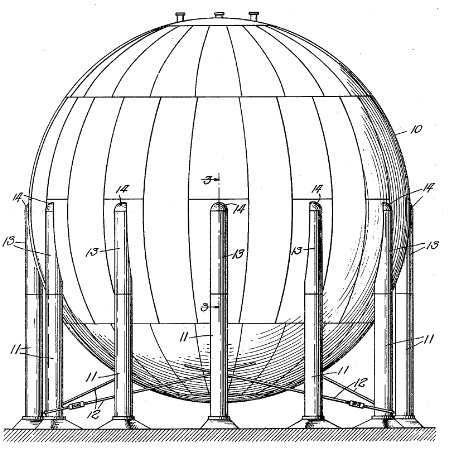
Horace Ebenezer Horton (1843-1912) founded the company that would build the world’s first “field-erected spherical pressure vessel.”
CB&I named its “Hortonspheres” after the engineer who had started the company in 1889 to build bridges across the Mississippi River. In 1892, CB&I erected its first elevated water tank in Fort Dodge, Iowa.
“The elevated steel plate tank was the first built with a full hemispherical bottom, one of the company’s first technical innovations,” CB&I noted, adding that the company built “the world’s first field-erected spherical pressure vessel” in 1923 at Port Arthur, Texas.
Learn more in Horace Horton’s Spheres.
September 24, 1951 – Perforating Wells with Bazooka Technology
When World War II veteran Henry Mohaupt applied to patent his “Shaped Charge Assembly and Gun,” he brought anti-tank technology to the petroleum industry — a downhole bazooka.
Mohaupt, a Swiss-born chemical engineer, during the war had conducted a secret U.S. Army program to develop an anti-tank weapon. His idea of using a conically hollowed-out explosive charge to focus detonation energy led to the rocket grenade used in bazookas.
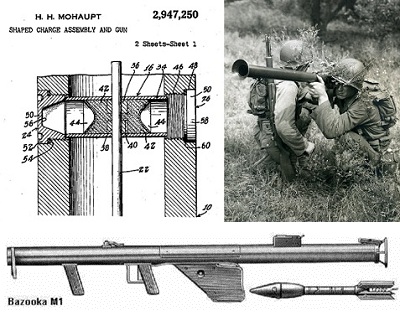
The patented “Shaped Charge Assembly and Gun” of Henry Mohaupt brought to the petroleum industry his World War II anti-tank “bazooka” technology.
After the war, the potential of these downhole rocket grenades to facilitate flow from oil-bearing strata was recognized by the Well Explosives Company of Fort Worth, Texas. The company employed Mohaupt to develop new technologies for safely perforating cement casing and pipe.
Learn more in Downhole Bazooka.
September 25, 1922 – First New Mexico Oil Well
Midwest Refining Company launched the New Mexico petroleum industry by completing the state’s first commercial oil well. Drilled near Shiprock on the Navajo Indian Reservation, the Hogback No. 1 well produced 375 barrels of oil per day.
Following the oilfield discovery, Midwest completed 11 more wells to establish the Hogback field as a major producer of the San Juan Basin. Two years later, a pipeline was built to Farmington, where oil was shipped by rail to refineries in Salt Lake City, Utah.
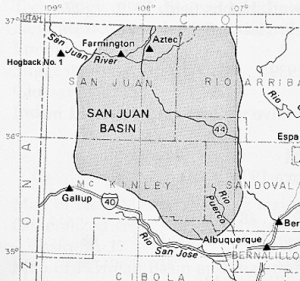
Midwest Refining Company discovered the Hogback oilfield in New Mexico’s San Juan Basin.
Production from the Hogback oilfield encouraged further exploration in New Mexico, leading to discoveries in 1928 at Hobbs in Lea County.
Learn more in First New Mexico Oil Wells.

September 26, 1876 – First Commercial California Oil Well
After three failed attempts, Charles Mentry’s California Star Oil Works Company discovered the Pico Canyon oilfield north of Los Angeles — California’s first commercial oil well. Drilled in a region known for natural oil seeps, the Pico No. 4 well produced 25 barrels of oil per day from a depth of 370 feet.
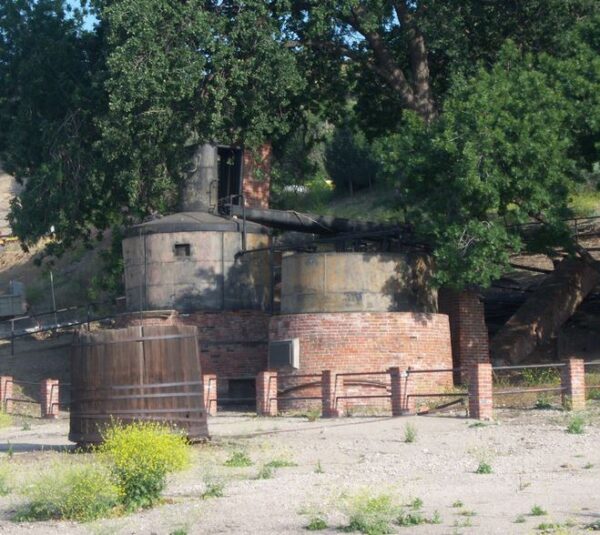
Preserved by the Santa Clarita Valley Historical Society, California’s first refinery includes riveted stills on brick foundations. Photo courtesy Konrad Summers.
Pico Canyon oilfield production would lead to construction of California’s first oil pipeline and the state’s first commercially successful oil refinery for making kerosene lamp fuel and lubricants. Riveted stills set on brick foundations had a refining capacity of 150 barrels of oil a day.
California Star Oil Works was acquired by Pacific Coast Oil Company in 1879, and the Pico Canyon oilfield discoverer became part of the Standard Oil Company of California (Socal) in 1906. Socal acquired Gulf Oil, the nation’s fifth-largest petroleum company at the time, in 1984 and adopted the brand name Chevron.
Learn more in First California Oil Wells.
September 26, 1933 – King Ranch Lease sets Record
Despite the reservations of Humble Oil and Refining Company’s president, geologist Wallace Pratt convinced the company to lease the almost million-acre King Ranch in Texas for almost $128,000 per year with a one-eighth royalty on any discovered oil.
Although Humble Oil and Refining, a Houston company founded in 1917, had not found oil on the ranch, the lease deal was the largest oil lease contract ever negotiated in the United States.
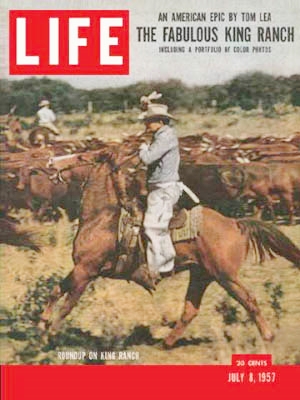
A 1933 King Ranch oil lease set a record.
Subsequent leases on nearby ranches gave Humble Oil & Refining nearly two million acres of mineral rights between Corpus Christi and the Rio Grande River.
By 1947, Humble operated 390 producing oil wells on the King Ranch lease alone. The company became ExxonMobil, which has regularly extended its 1933 King Ranch lease agreement.
Learn more in Oil Reigns at King Ranch.

September 26, 1943 – First Florida Oil Well
Near a watering stop on the Atlantic Coast Line Railroad in southwestern Florida, the Humble Oil and Refining Company completed the state’s first commercial oil well, the Sunniland No. 1. The company had spent $1 million drilling to a depth of about 11,600 feet to complete the discovery well, located 12 miles south of Immokalee, near Big Cypress Preserve and the resort city of Naples.
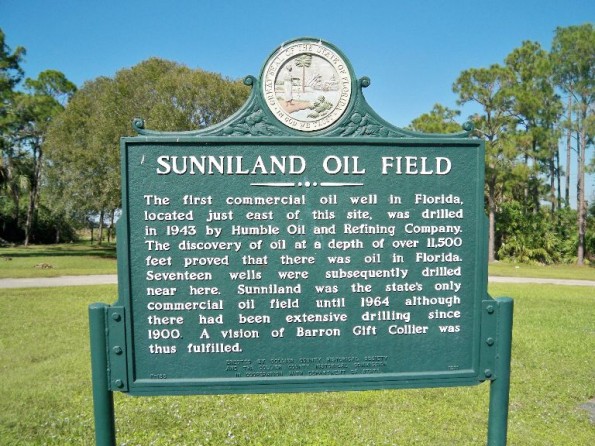
Humble Oil and Refining Company donated $60,000 to the University of Florida and the Florida State College for Women.
Florida oilfields had eluded discovery for decades. With almost 80 “dry holes” drilled by 1939, Florida legislators offered a $50,000 bounty for the first oil discovery. The Sunniland oilfield brought more drilling, and by 1954 the field was producing 500,000 barrels of oil per year from 11 wells.
Texas-based Humble Oil accepted the $50,000 prize offered by the state legislature, added $10,000 — and donated the $60,000 equally between the University of Florida and the Florida State College for Women. Humble later became ExxonMobil.
Learn more in First Florida Oil Well.
September 27, 1915 – Deadly Explosion in Ardmore, Oklahoma
A railroad car carrying casinghead gasoline exploded in Ardmore, Oklahoma, killing 43 people and injuring others. The car, which had arrived the day before, was waiting to be taken to a nearby refinery. Casinghead gasoline (also called natural gasoline) at the time was integral to the state’s petroleum development, with 40 processing plants in operation.
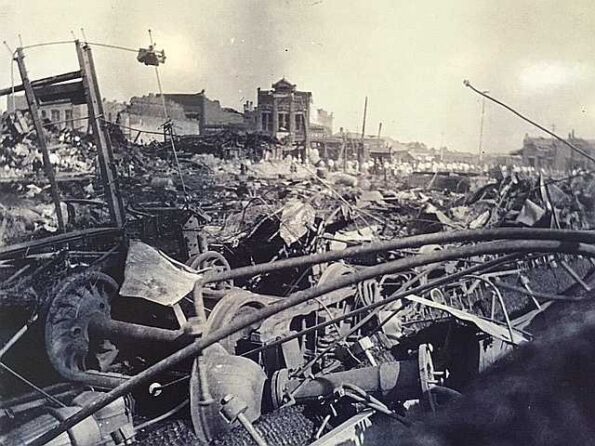
A casing gas explosion destroyed most of downtown Ardmore, Oklahoma, in 1915. Photo courtesy Oklahoma Historical Society.
According to the Oklahoma Historical Society (OHS), the disaster began when rising afternoon temperatures activated a valve to release the car’s gas pressure. “The Ardmore Refining Company then sent a representative, who removed the dome from the top of the car, filling the air with gas and vapors.”
Triggered by an unidentified source, the explosion destroyed much of downtown Ardmore. The Atchison, Topeka & Santa Fe Railway was found responsible for the explosion and paid 1,700 claims totaling $1.25 million, OHS reported, adding, “Oil companies changed and improved the extraction and transportation methods for natural gasoline.”
September 28, 1945 – Truman claims America’s Outer Continental Shelf
President Harry Truman extended U.S. jurisdiction over the natural resources of the outer continental shelf, placing them under the control of the Secretary of the Interior. In August 1953, Truman’s edict would become the Outer Continental Shelf Lands Act, which affirmed exclusive jurisdiction over the U.S. continental shelf and a federal leasing program “to encourage discovery and development of oil.”
The earliest U.S. offshore wells were drilled on lakes; learn more in Offshore Oil & Gas History articles.
______________________
Recommended Reading: Signal Hill, California, Images of America (2006); Black Gold in California: The Story of California Petroleum Industry
(2006); Black Gold in California: The Story of California Petroleum Industry  (2016); Handbook of Petroleum Refining Processes
(2016); Handbook of Petroleum Refining Processes (2016);The Bazooka
(2016);The Bazooka (2012); The Extraction State, A History of Natural Gas in America (2021); The Bazooka
(2012); The Extraction State, A History of Natural Gas in America (2021); The Bazooka (2012); Wireline: A History of the Well Logging and Perforating Business in the Oil Fields
(2012); Wireline: A History of the Well Logging and Perforating Business in the Oil Fields (1990); The story of oil in New Mexico – Scenic trips to the geologic past (1989); Black Gold in California: The Story of California Petroleum Industry
(1990); The story of oil in New Mexico – Scenic trips to the geologic past (1989); Black Gold in California: The Story of California Petroleum Industry  (2016); Kings of Texas: The 150-Year Saga of an American Ranching Empire
(2016); Kings of Texas: The 150-Year Saga of an American Ranching Empire  (2003); Oil in the Deep South: A History of the Oil Business in Mississippi, Alabama, and Florida, 1859-1945
(2003); Oil in the Deep South: A History of the Oil Business in Mississippi, Alabama, and Florida, 1859-1945 (1993). Your Amazon purchase benefits the American Oil & Gas Historical Society. As an Amazon Associate, AOGHS earns a commission from qualifying purchases.
(1993). Your Amazon purchase benefits the American Oil & Gas Historical Society. As an Amazon Associate, AOGHS earns a commission from qualifying purchases.
_______________________

_______________________
The American Oil & Gas Historical Society (AOGHS) preserves U.S. petroleum history. Please become an AOGHS annual supporter and help maintain this energy education website and expand historical research. For more information, contact bawells@aoghs.org. Copyright © 2025Bruce A. Wells. All rights reserved.
by Bruce Wells | Sep 15, 2025 | This Week in Petroleum History
September 15, 1886 – Trenton Field brings Indiana Gas Boom –
The Eaton Mining & Gas Company, recently established by George W. Carter and a group of investors, discovered a giant natural gas field near Portland, Indiana, at a depth of 922 feet. They had been encouraged by earlier discoveries, including the January “Great Karg Well” in Ohio. The Indiana well revealed what proved to be the Trenton Limestone. (more…)
by Bruce Wells | Sep 8, 2025 | This Week in Petroleum History
September 8, 1891- Patent issued for “Flexible Driving Shafts” –
The modern concept of horizontal drilling may have begun with 19th-century patents by John Smalley Campbell of London. After receiving a British patent for his “useful improvements in flexible driving shafts or cables” in 1889, Campbell received a U.S. patent (no. 459,152) for his drilling method.
While Campbell described his directional drilling patent as ideal for dental engines, “the patent also carefully covered use of his flexible shafts at much larger and heavier physical scales,” reported geologist and oil historian Stephen M. Testa in a 2015 article for Pacific Petroleum Geology.
“The modern concept of non-straight line, relatively short-radius drilling dates back at least to September 8, 1891,” Testa added. Directional drilling pioneer H. John Eastman in 1933 applied the technology to save the Conroe oilfield.
September 10, 1969 – Second Nuclear Fracturing Test
A 40-kiloton nuclear device was detonated about eight miles southeast of present-day Parachute, in Garfield County, Colorado. Project Rulison was the second of three natural-gas-reservoir stimulation tests that were part of Operation Plowshare, a government program to study uses of nuclear explosives for peaceful purposes.
The first nuclear fracturing test, Project Gasbuggy, detonated a 29-kiloton device in a New Mexico well in December 1967. The third unconventional test to increase production was Project Rio Blanco, a 1973 detonation in a Rio Blanco County, Colorado, natural gas well. (more…)
by Bruce Wells | Sep 1, 2025 | This Week in Petroleum History
September 1, 1862 – Union taxes Manufactured Gas –
A new federal tax of up to 15 cents per thousand cubic feet was placed on manufactured gas to help fund the Civil War. Often processed from coal and stored in large gasometers, “town gas” had become popular for street and residential lighting. The Brooklyn Daily Eagle accused the local gas company of passing on the new tax, which “shifts from its shoulders its share of the burdens the war imposes and places it directly on their customers.” (more…)






(2009); Where it All Began: The story of the people and places where the oil & gas industry began: West Virginia and southeastern Ohio
(1994); Black Gold, Patterns in the Development of Wyoming’s Oil Industry (1997); Tulsa Where the Streets Were Paved With Gold – Images of America
(2000); Offshore Pioneers: Brown & Root and the History of Offshore Oil and Gas
(1997); Western Pennsylvania’s Oil Heritage
(2008); Oil and Gas Pipeline Fundamentals
(1993); Arizona Rocks & Minerals: A Field Guide to the Grand Canyon State
(2010). Your Amazon purchase benefits the American Oil & Gas Historical Society. As an Amazon Associate, AOGHS earns a commission from qualifying purchases.


























